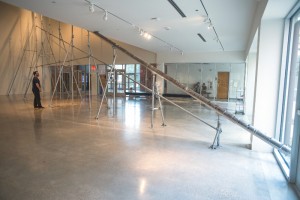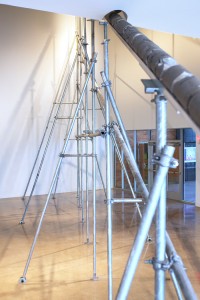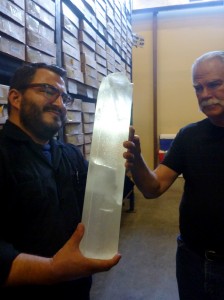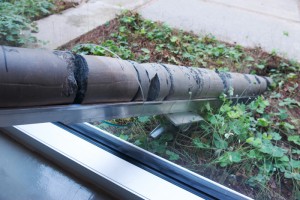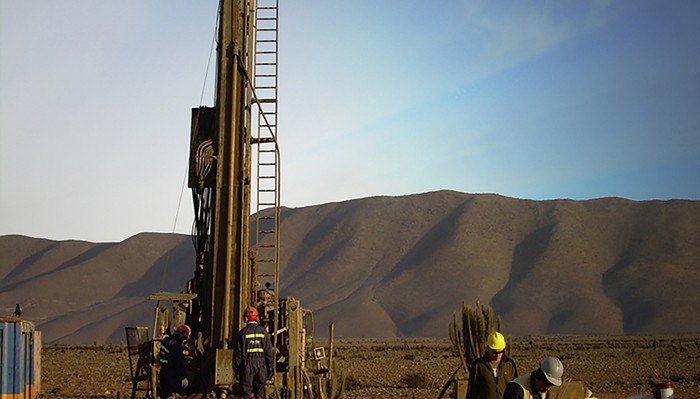
Topical Topography: A Journey from the Permian Basin to the Prius by David Brooks
Imagine yourself in Central Park one million years ago. You would be standing on a vast ice sheet, a 4,000-mile glacial wall, as much as 2,000 feet thick. Alone on the vast glacier, you would not sense its slow crushing, scraping, ripping movement as it advanced south, leaving great masses of rock debris in its wake. Under the frozen depths, where the carousel now stands, you would not notice the effect on the bedrock as the glacier dragged itself along.
—Robert Smithson, Fredrick Law Olmsted and the Dialectical Landscape
I often find my perceptual capacities working in direct conflict with both my conceptual curiosities and emotional barometer when it comes to comprehending place – whether particularly or generally. Perhaps it is not until we can think outside of our momentary time and space that we can begin to ascertain the constellatory nuances of place more fully and more accurately, even if just taking a walk through Central Park.
When the director of the Visual Arts Center (VAC) at the University of Texas at Austin invited me to be an Artist-in-Residence and formulate an exhibition for the Department of Art and Art History, we discussed how the VAC has historically collaborated with other departments at UT at Austin. Being one of the country’s great research universities I knew I would be in my element. I had no preconceived idea of what would come of this precisely, until I started researching. I did know, however, that I wanted to find a meaningful way of working with the Jackson School of Geosciences because, as a northerner, when I think “Texas”, I think “oil”, as does much of the country. I wanted to take this opportunity to look beyond conventional understandings of the petroleum industry, to subvert typically didactic and dead end frameworks. There are enough people pointing their fingers at BP and their brethren in Big Oil, and my finger would not add much to that conversation. That would simply be beating a dead horse.
I wanted, rather, to expound on the material culture (literally material, e.g. rock, dirt, dust, and drills) of an industry that engages such large, vast, unfathomable, and unquantifiable scales of carbon (32 billion barrels of liquid fuels annually), time (250 million year old petroleum), money (trillion dollar revenue streams), political empowerment (enough to start wars), and its measurable but elusive atmospheric impact. To couch a conversation of climate change—it’s millennia of geo-cycles and the bellicose political climate of the day within the immovable and cumbersome presence of a rock—puts the debate into a granular perspective. This was at the core of my dilemma and at the core of my project, and this could really only be done in Texas.
At the turn of the twentieth century, long before the advent of core technology, when prospectors were looking for oil they would use rotary drilling techniques of large augers to bore into the earth’s surface, maxing out at depths around 1,000 feet. At ten-foot increments the drill would be raised back to the surface and the cuttings would be shaken off the drill tip. Those rock cuttings would be cleaned and kept in either envelopes or glass vials and catalogued in their respective sequence of depths. Their compositions would then be analyzed for various elements, including the detection of hydrocarbons indicating the presence of oil. The great oil boom of Texas was sparked when one such drill struck a reservoir at a mere 1,020 feet below the earth’s surface before it erupted into a gusher. That would be the famed “Spindletop” field of 1901, and it marked the beginning of the Oil Age. As Texas quickly advanced to being the most oil-productive state in the U.S., the country consequently overtook the Russian Empire as the top producer of petroleum at that time. So the technology of its geophysicists also advanced, paving the way for core drilling. Core technology has allowed geophysicists to extract whole five-inch diameter cylindrical cores, in lengths from three feet to 1,500 feet, and extracted from depths greater than 30,000 feet.
From the early prospecting of the Beaumont region of eastern Texas, to the heyday of the Permian Basin in Northwest Texas—as well as the current trends toward fracking the Eagle Ford Shale—the search for oil in these 250 million year old sediments has ebbed and flowed depending on economic and political factors as well as the people and personalities running the show. An aesthetic perspective of land is as malleable, topical and conflicted as is our use of that land. Biota, abiota, economies and ideologies have only become more inextricably linked as the stakes get higher and the resources become scarcer. One need only remember how the fecundity of the west fueled the rise of industrial progress under the mantra of Manifest Destiny; or how the Hudson River School’s view of North America as a garden of Eden propagated a sense of pastoral idealism in which man seemingly lived in harmony with nature, albeit through an agrarian imposition.
At the Austin Core Research Center (CRC) of the University of Texas there is a hangar-sized warehouse containing an archive of more than two million rock core samples and well logs. These vast holdings span the entire era of prospecting for oil in Texas, from the late nineteenth century, through the oil boom years, to today, with more recent examples also coming from elsewhere in the United States and abroad. Core samples are now extracted at a cost of more than four million dollars per sample. Once the productivity of a well or reservoir is determined, petroleum companies have no reason to keep these cores and cuttings. However, finding great value in the geological data provided by these costly and irreplaceable artifacts, the University of Texas at Austin does, and has for decades been amassing a monumental repository of these by-products of the oil industry.
The stories buried within these stones laid dormant for 250 million years before they were excavated during the oil boom. Now, at the CRC, they await either the renewed attention of geologists, or further technological advancements that will allow the detection of lower levels of hydrocarbons and the more efficient extraction of fossil fuels from the samples’ point of origin. Recently, with advancements in hydraulic fracturing technology, popularly known as fracking, and the volatility of the energy market, this sleepy archive of stone is awakened more frequently. Given that housing communities and other large-scale developments have been built on what was once the uninhabited land from which older cores and cuttings were extracted decades ago, the prospects of sampling underneath these densely populated areas proves too costly and bureaucratically complex. Thus, the original samples are proving invaluable for studying and prospecting these lands.
One of the more unique archives within this larger archive consists of a notably antique but well-organized set of drawers, dating back to the first decades of the twentieth century. Within each of these drawers are dozens of glass vials containing rock cuttings, all neatly arranged and hand-labeled to note the depth from which they were taken within their respective wells. With eighty vials per drawer, ten drawers per box, ten boxes per shelf, fourteen shelves per bay, and sixty bays, totaling nearly seven million vials, the architecture required to house this archive within an archive takes on a visual opulence as expansive as its contents. As the samples were collected in the field, and shuttled from one lab to another, there was a risk that the movement would agitate the sediments and disturb their composition, not to mention the possibility of the glass vials breaking. One obvious solution to the problem of excessive rattling was to simply stuff the day’s newspaper into each drawer. By so doing, a third archive was incidentally amassed: each of the above mentioned drawers, containing their 250 million year old contents, fastidiously arranged during the early twentieth century’s frenzy of oil discoveries, also contains pages from periodicals and newspapers (from The New York Times to the Houston Chronicle to the American Statesman) offering accounts of the topical and quotidian goings-on of the day. Spanning news from the period between the world wars and after, this archive within an archive within an archive also laid dormant until a group of MFA students from the University of Texas at Austin accompanied me in February 2014 to reawaken these artifacts of a bygone era. The frenzy of the students pillaging the drawers to find articles of interest to them starkly juxtaposed this century-long history with the millennia of the geologic material blanketed by the journalistic musings of the day. To my eyes, this created a real live imbroglio, confounding the old-fashioned space-time continuum.
I came to work with this storied material through a longstanding interest in finding mediations rather than bifurcations between the natural world and the cultural sphere. The material culture of the petroleum industry profoundly intertwines the realms of geology, evolution, and the commodification of the natural world, whilst it literally fuels the motions of our daily lives. However, people in general don’t really relate to a rock. The story is too big, too vast, and therefore too hypothetical. One way to access geological time is through evolutionary time. For example, we can relate to another primate. It does not take too much imagination to consider our similarities. If you continue to expand that notion of evolutionary time further and further, it expands our notions of how to think of the systems around us, and how to think about the material world in a more meaningful way in the present moment, the present moment as topically addressed in The New York Times or the Houston Chronicle as it is in the drawers at the CRC, carefully cushioning their geologic contents.
The centerpiece of my project culminated in the installation of a seventy-foot long geologic core sample that I acquired from the CRC archives and used to dissect the VAC’s vaulted gallery space. All data concerning the core’s location of extraction had long since been lost; however, its depth of extraction is known to be precisely 5,285 feet. The repositioning of the core worked to both acknowledge and defy the given exhibition space. From a great height it bored a hole in the wall and pierced through a glass windowpane before returning to the ground in the exterior courtyard. The dynamism of the core’s trajectory reanimated itself in relation to the surrounding architecture: the core became an active object in the gallery, and the gallery became a clearly defined space that could now be pierced. Here the built environment is intertwined with an artifact formed over millions of years, creating a multidimensional experience of the situation. To ascertain the wholeness of the core means to synthesize one’s faculties of imagination with one’s sensory experience in the present moment. One cannot experience the core 5,825 feet in the ground, nor experience millions of years therefore the viewer must imagine such truths in order to know this object that is so overtly defining their experience.
Imagine yourself in the Permian Basin (present day Midland, Texas) 250 million years ago. You would be standing on the edge of a dying rainforest and an arc of desertification would slowly be enveloping the supercontinent of Pangea. Alone on this vastly expanding desert topography, you would not sense the slow compressing, heating and fossilizing of the tropical vegetation that would become crude oil in millennia to come. Under the sulfur rich depths, where a Toyota Prius now speeds by, you would not notice the effect of tectonic rifts folding ancient topographies in on themselves, like kneaded dough—forming vast reservoirs of petroleum that would come to fuel the motions of our daily lives today.
Tags: David Brooks, Journal
